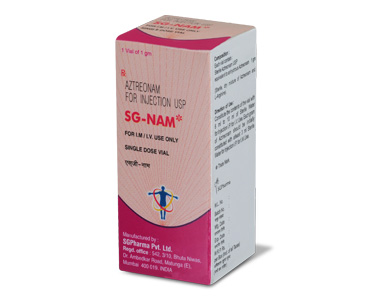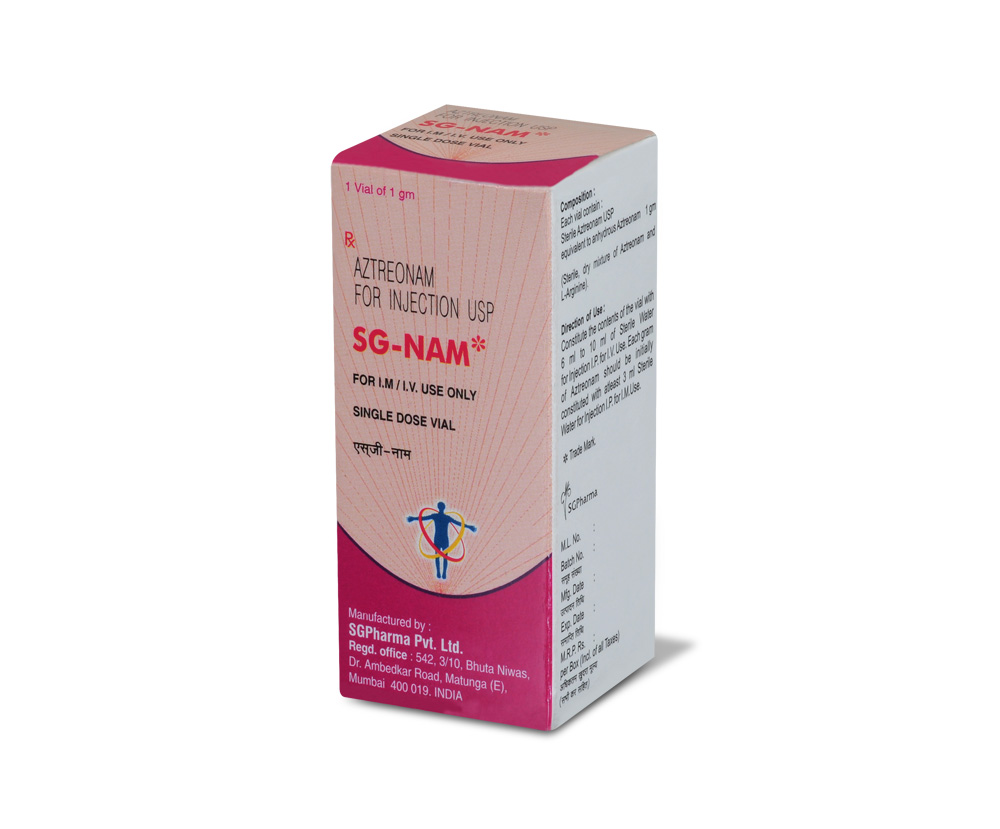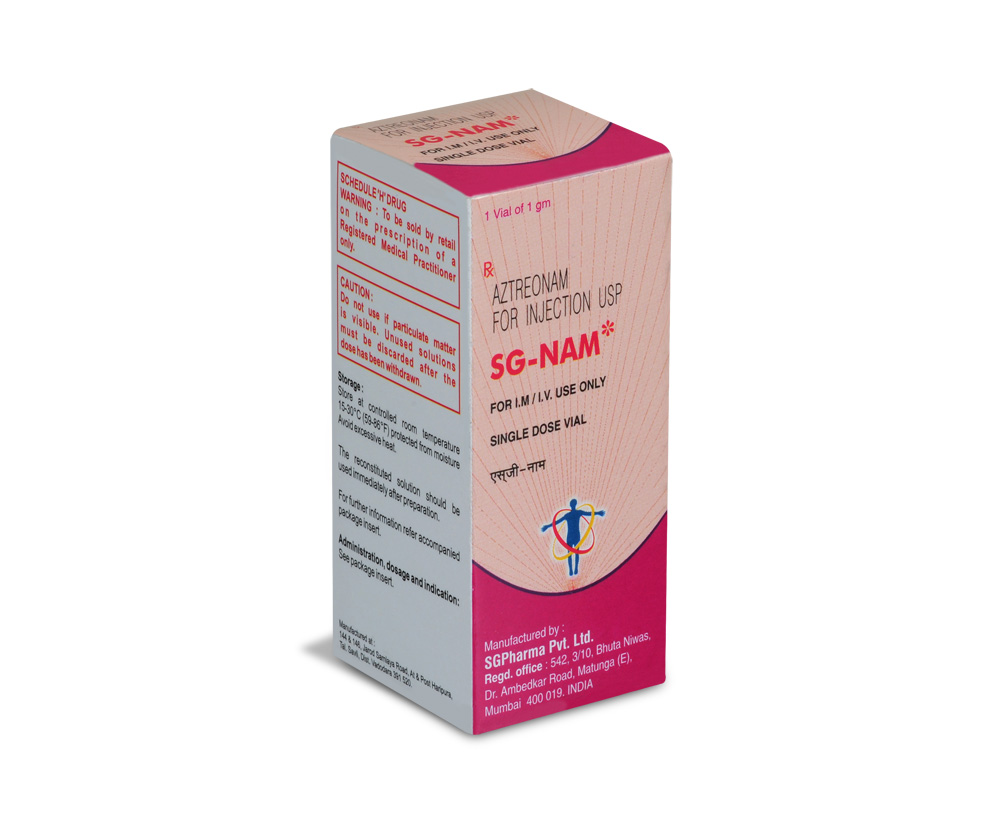
500 mg, 1 gm
For the use of a Registered Medical Practitioner or a Hospital or a Institution only.
SG-NAM (Aztreonam) is a monobactam. It was originally isolated from Chromobacterium violaceum. It is a synthetic bactericidal antibiotic. Chemically, Aztreonam is (Z)-2-[[[(2-amino- 4-thiazolyl)[[(2S,3S)-2-methyl-4-oxo-1-sulfo-3-zetidinyl]carbamoyl]methylene]amino]oxy]-2-methylpropionic acid. The molecular formula is C13H17N5O8S2 and molecular weight is 435.43.
STRUCTURAL FORMULA :
Its structural formula is :
-Structure.jpg)
SG-NAM is a sterile, nonpyrogenic, sodium-free, white powder containing approximately 780 mg L-arginine per gram of aztreonam.
COMPOSITION :
Each vial contains :
Sterile Aztreonam USP
equivalent to anhydrous Aztreonam 1 gm
(Sterile mixture of Aztreonam and L-Ariginine)
ACTIONS :
Aztreonam is a monocyclic beta lactam antibiotic with potent bactericidal activity against a wide spectrum of gram negative aerobic pathogens. Unlike the majority of beta-lactam antibiotics, it is not an inducer in vitro of beta-lactamase activity. Aztreonam is usually active in vitro against those resistant aerobic organisms whose beta-lactamases hydrolyse other antibiotics.
PHARMACOKINETICS :
Single 30-minutes intravenous infusions of 500 mg, 1 g and 2 g doses of Aztreonam for Injection USP in healthy subjects produced peak serum levels of 54, 90 and 204 µg/ml respectively, immediately after administration; at eight hours, serum levels were 1, 3 and 6 µg/ml, respectively. Single 3-minute intravenous injections of the same doses resulted in serum levels of 58, 125 and 242 µg/ml at five minutes following completion of injection. The serum levels of aztreonam following single 500 mg or 1 g (intramuscular or intravenous) or 2 g (intravenous) doses exceed the MIC90 for Neisseria sp., H. influenzae and most genera of the Enterobacteriaceae for eight hours (for Enterobacter sp., the eight hours serum levels exceed the MIC for 80 % of strains). For Ps. aeruginosa, a single 2 g intravenous dose produces serum levels that exceed the MIC90 for approximately four to six hours. When aztreonam pharmacokinetics were assessed for adult and paediatric patients, they were found to be comparable. The serum half-life of aztreonam averaged 1.7 hours (1.5 to 2.0) in subjects with normal renal function, independent of the dose and route of administration. In healthy subjects, based on a 70 kg person, the serum clearance was 91 ml/min and renal clearance was 56 ml/min; the apparent mean volume of distribution at steady-state averaged 12.6 litres, approximately equivalent to extracellular fluid volume.
In a study of healthy elderly male subjects (65 to 75 years of age), the average elimination half-life of aztreonam was slightly longer than in young healthy males. In patients with impaired renal function, the serum half-life of aztreonam is prolonged. The serum half-life of aztreonam is only slightly prolonged in patients with hepatic impairment since the liver is a minor pathway of excretion. Approximately 60 to 70 % of an intravenous or intramuscular dose was recovered in the urine by eight hours. Urinary excretion of a single parenteral dose was essentially complete by 12 hours after injecftion. About 12 % of a single intravenous radiolabeled dose was recovered in the faeces. Unchanged aztreonam and the inactive beta-lactam ring hydrolysis product of aztreonam were present in faeces and urine.
Intravenous or intramuscular administration of a single 500 mg or 1 g dose of aztreonam every eight hours for seven days to healthy subjects produced no apparent accumulation of aztreonam or modification of its disposition characteristics; serum protein binding averaged 56 % and was independent of dose. Aztreonam achieves measurable concentrations in the following body fluids and tissues :
EXTRAVASCULAR CONCENTRATIONS OF AZTREONAM AFTER A SINGLE PARENTERAL DOSE
-Table-1.jpg)
-Table-2.jpg)
-Table-3.jpg)
-Table-4.jpg)
Urinary Tract Infections : (complicated and uncomplicated), including pyelonephritis and cystitis (initial and recurrent) caused by Escherichia coli, Klebsiella pneumoniae, Proteus mirabilis, Pseudomonas aeruginosa, Enterobacter cloacae, Klebsiella oxytoca, Citrobacter species and Serratia macescens.
Administration :
Aztreonam may be administered intravenously or by intramuscular injection. Dosage and route of administration should be determined by susceptibility of the causative organisms, severity and site of infection and the condition of the patient. The intravenous route is recommended for patient requiring single doses greater than 1 g or those with bacterial septicaemia, localized parenchymal abscess (intra-abdominal abscess), peritonitis or other severe systemic or life-threatening infections.
Dosage :
Dosage in adult patients :
The duration of therapy depends on the severity of infection. Generally, aztreonam should be continued for at least 48 hours after the patient becomes asymptomatic or evidence of bacterial eradication has been obtained. Persistent infections may require treatment for several weeks. Renal impairment in adult patients for serious or life threatening infections, in addition to the maintenance doses, one eighth of the initial dose should be given after each haemodialysis session.
Dosage in the elderly :
Renal status is a major determinant of dosage in the elderly; these patients in particular may have diminished renal function. Serum creatinine may not be an accurate determinant of renal status. Therefore, as with all antibiotics eliminated by the kidneys, estimates of creatinine clearance should be obtained, and appropriate dosage modifications made if necessary.
Dosage in paediatric patients :
Aztreonam should be administered intravenously to paediatric patients with normal renal function. There are insufficient data regarding intramuscular administration to paediatric patients or dosing in paediatric patients with renal impairment. Because of the serious nature of infections due to Pseudomonas aeruginosa, dosage of 2 g every six or eight hours is recommended, at least upon initiation of therapy, in systemic infections caused by this organism in adults.
Preparation of Parenteral Solutions :
General :
Upon the addition of the diluent to the container, contents should be shaken immediately and vigorously. Constituted solutions are not for multiple-dose use; should the entire volume in the container not be used for a single-dose, the unused solution must be discarded.
Depending upon the concentration of aztreonam and diluent used, constituted SG-NAM yields a colourless to light straw yellow solution which may develop a slight pink tint on standing (potency is not affected). Parenteral drug products should be inspected visually
for particulate matter and discoloration whenever solution and container permit.
Intravenous (IV) Solutions :
For Bolus Injection :
The contents of SG-NAM 20 ml or 30 ml capacity vial should be constituted with 6 ml to 10 ml Sterile Water for Injection I.P. for Infusion : If the contents of a 20 ml or 30 ml capacity vial are to be transferred to an appropriate infusion solution, each gm of aztreonam should be initially constituted with at least 3 ml Sterile Water for Injection I.P. Further dilution may be obtained with one of the following intravenous infusion solutions :
• Sodium Chloride Injection USP 0.9 %
• Ringer’s Injection USP
• Lactated Ringer’s Injection USP
• bDextrose Injection USP 5 % or 10 %
• Dextrose and Sodium Chloride Injection USP 5 % : 0.9 %, 5 % : 0.45 % or 5 % : 0.2 %
• Sodium Lactate Injection USP (M/6 Sodium Lactate)
tability of I.V. and I.M. Solutions :
Aztreonam solutions for I.V. infusion at concentrations not exceeding 2 % w/v must be used within 48 hours following constitution if kept at controlled room temperature (15°-30°C/59°-86°F) or within seven days if refrigerated (2°-8°C /36°-46°F). Aztreonam solutions at concentrations exceeding 2 % w/v, except those prepared with Sterile Water for Injection USP or Sodium Chloride Injection USP should be used promptly after preparation; the two solutions must be used within 48 hours if stored at controlled room temperature or within seven days if refrigerated.
CONTRAINDICATIONS :
Patients with a known hypersensitivity to aztreonam and L-arginine. If such severe reactions occur, SG-NAM should be discontinued and the patient treated with the appropriate agents, eg. adrenaline, corticosteroids, aminophylline and antihistamines.
Pseudomembranous colitis has been reported with many broad spectrum antibiotics, therefore it is important to consider its diagnosis in patients who develop diarrhoea in association with its use. Such colitis may be life-threatening and appropriate measures should be taken, including discontinuation of the antibiotic.Efficacy of SG-NAM in the prophylaxis of rheumatic fever has not been established.
PRECAUTIONS :
General :
In patients with impaired hepatic or renal function, appropriate monitoring is recommended during therapy. If an aminoglycoside is used concurrently with aztreonam, especially if high dosages of the former are used or if therapy is prolonged, renal function should be monitored because of the potential nephrotoxicity and ototocicity of aminoglycoside antibiotics.As with other antibiotics, in the treatment of acute pulmonary exacerbations in patients with cystic fibrosis, while clinical improvement is usually noted, lasting bacterial eradications may not be achieved. The use of antibiotics may promote the overgrowth of nonsusceptible organisms, including gram-positive organisms (Staphylococus aureus and Streptococcus faecalis) and fungi. If superinfection occurs during therapy, appropriate measures should be taken. It is recommended that prothrombin time should be monitored if the patient is on concomitant anticoagulant therapy.
Pregnancy : Category B
Aztreonam crosses the placenta and enters the foetal circulation. Studies in pregnant rats and rabbits, with daily doses up to 15 and 5 times, respectively, the maximum recommended human dose, revealed no evidence of embryo or foetotoxicity or teratogenicity. No drug induced changes were seen in any of the maternal, foetal, or neonatal parameters that were monitored in rats receiving 15 times the maximum recommended human dose of aztreonam during late gestation and lactation. There are no adequate and well-controlled studies in pregnant women. Because animal reproduction studies are not always predictive of human response, aztreonam should be used during pregnancy only if clearly needed.
Nursing mothers :
Aztreonam is excreted in breast milk in concentrations that are less than 1 % of concentrations determined in simultaneously obtained maternal serum; consideration should be given to temporary discontinuation of nursing and use of formula feedings.
Paediatric use :
The safety and effectiveness of intravenous aztreonam have been established in the age groups 9 months to 16 years. Use of aztreonam in these age groups is supported by evidence from adequate and well-controlled studies of aztreonam in adults with additional efficacy, safety, and pharmacokinetic data from non-comparative clinical studies in paediatric patients. Sufficient data are not available for paediatric patients under 9 months of age or for the following treatment
indications/pathogens :
septicemia and skin and skin-structure infections (where the skin infection is believed or known to be due to H. influenzae type b). in paediatric patients with cystic fibrosis, higher doses of aztreonam may be warranted.
INTERACTIONS AND INCOMPATIBILITIES :
Single dose pharmacokinetic studies have not shown any significant interaction between aztreonam and gentamicin, cephradine, clindamycin or metronidazole. Unlike broad spectrum antibiotics, aztreonam produces no effects on the normal anaerobic intestinal flora. No disulfuram-like reactions with alcohol ingestion have been reported.
SIDE EFFECTS :
Local reactions such as phlebitis/thrombophlebitis following I.V. administration, and discomfort/swelling at the injection site following I.M. administration occurred at rates of approximately 1.9 % and 2.4 %, respectively. Systemic reactions (considered to be related to therapy or of uncertain etiology) occurring at an incidence of 1 to 1.3 % include diarrhoea, nausea and/or vomiting, and rash. Reactions occurring at an incidence of less than 1 % are listed within each body system in order of decreasing severity :
Hypersensitivity : Anaphylaxis, angiooedema, bronchospasm.
Haematology : Pancytopaenia, neutropaenia, thrombocytopaenia, anaemia, eosinophilia, leukocytosis, thrombocytosis.
Gastrointestinal : Abdominal cramps; rare cases of C. difficile - associated diarrhoea, including pseudomembraneous colitis, or gastrointestinal bleeding have been reported. Onset of pseudomembranous colitis symptoms may occur during or after antibiotic treatment.
Dermatologic : Toxic epidermal necrolysis, purpura, erythema multiforme, exfoliative dermatitis, urticaria, petechiae, pruritus, diaphoresis.
Cardiovascular : Hypotension, transient ECG changes (ventricular bigeminy and PVC), flushing.
Respiratory : Wheezing, dyspnoea, chest pain.
Hepatobiliary : Hepatitis, jaundice.
Nervous System : Seizure, confusion, vertigo, paresthesia, insomnia, dizziness.
Musculoskeletal :Muscular aches.
Special Senses : Tinnitus, diplopia, mouth ulcer, altered taste, numb tongue, sneezing, nasal congestion, halitosis.
Other : Vaginal candidiasis, vaginitis, breast tenderness.
Body as a whole : Weakness, headache, fever, malaise.
Paediatric Adverse Reactions :
Of the 612 paediatric patients who were treated with SG-NAM in clinical trials, less than 1 % required discontinuation of therapy due to adverse events. The following systemic adverse events, regardless of drug relationship, occurred in at least 1 % of treated patients in domestic clinical trial : rash (4.3 %), diarrhoea (1.4 %), and fever (1.0 %). These adverse events were comparable to those observed in adult clinical trials. In 343 paediatric patients receiving intravenous therapy, the following local reactions were noted : pain (12 %), erythema (2.9 %), induration (0.9 %), and phlebitis (2.1 %). In the US patient population, pain occurred in 1.5 % of patients, while each of the remaining three local reactions had an incidence of 0.5 %. The following laboratory adverse events regardless of drug
relationship, occurred in at least 1 % of treated patients : increased eosinophils (6.3 %), neutropaenia (3.2 %), increased AST (3.8 %), increased ALT (6.5 %), and increased serum creatinine (5.8 %).

 Cardiovascular
Cardiovascular






